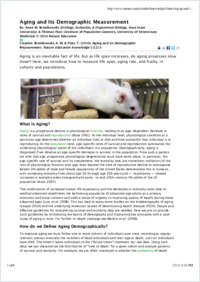Aging and Its Demographic Measurement
- Bronikowski, Anne M. Iowa State University
- Flatt, Thomas University of Veterinary Medicine Vienna
-
2010
Published in:
- Nature Education Knowledge. - 2010, vol. 1, no. 12, p. 1-6
English
This case study highlights the general issues raised earlier. First, that maximum lifespan is not an easily obtainable metric. Specifically, it is unambiguous in the sense that once the last animal dies, it is most definitely dead. But to estimate the variance in maximum lifespan, many replicate populations would need to be followed for each treatment group (with each replicate providing a single observation of maximum lifespan). Second, median lifespan, although measurable from a single population, provides no information on the age-specificity and patterns in age-specific vital rates that are contributing to differences in "aging" (i.e., differences in physiological frailty and rates of increasing mortality across the adult lifespan). Finally, our partitioning of aging into two components — IMR and RoA — allows us to unravel causation in a demographic sense. Specifically, it allows us to specify an aging rate that is separate from its starting value (IMR), independent of fluctuations in survival due to temporary experimental impacts, and not necessarily equivalent to expectations due to median or maximum lifespan.
- Faculty
- Faculté des sciences et de médecine
- Department
- Département de Biologie
- Language
-
- English
- Classification
- Biological sciences
- Other electronic version
- License
-
License undefined
- Identifiers
-
- RERO DOC 324346
- Persistent URL
- https://folia.unifr.ch/unifr/documents/307730
Statistics
Document views: 333
File downloads:
- Texte intégral: 290
